How Much Can You Lose with Bonds?
A lot.
September 2022. Reading Time: 10 Minutes. Author: Nicolas Rabener.
SUMMARY
- Bonds are typically considered safe investments
- However, there were decades of negative real returns
- Drawdowns reached 50% for U.S. Treasuries and Bonds
INTRODUCTION
Inflation greater than 10% was unknown for the majority of people in developed markets before this year, but it is nothing particularly new for emerging market citizens. Russia experienced 15.5% in 2015, India 10.1% in 2013, Brazil 14.7% in 2003, and Turkey 19.6% in 2021. Holding cash becomes expensive as savings rates are often below inflation, so consumers spend their incomes, invest in hard assets like real estate, or try to move their money into different currencies.
U.S. investors need to go back to 1990 for inflation greater than 5%, or 1981 for inflation above 10%. Although the average inflation in the United States was a moderate 3.1% in the 93 years between 1928 and 2021, this includes times with high and low, even negative, inflation rates.
Most investors have portfolios predominantly comprised of bonds and stocks. Although 2022 has highlighted that even government bonds can decline in value, many investors still perceive bonds as safe investments (read No Longer Superheroes? Twilight of the Bonds).
In this research note, we explore how much money can be lost with bonds.
NOMINAL VERSUS REAL RETURNS
We will use a data set from Professor Aswath Damodaran from New York University that includes the annual historical returns for stocks, bonds, and real estate in the U.S. from 1928 to 2021.
First, we divide the entire period into quartiles based on inflation rates and show the average annual returns for the S&P 500, 3-month U.S. Treasury Bills, 10-Year U.S. Treasury Bonds, and U.S Corporate Bonds. We observe diverse returns for the different assets across the four inflation regimes, albeit all were positive. At first glance, this could reassure investors that even with inflation above 4% no negative returns should be incurred on bond investments.
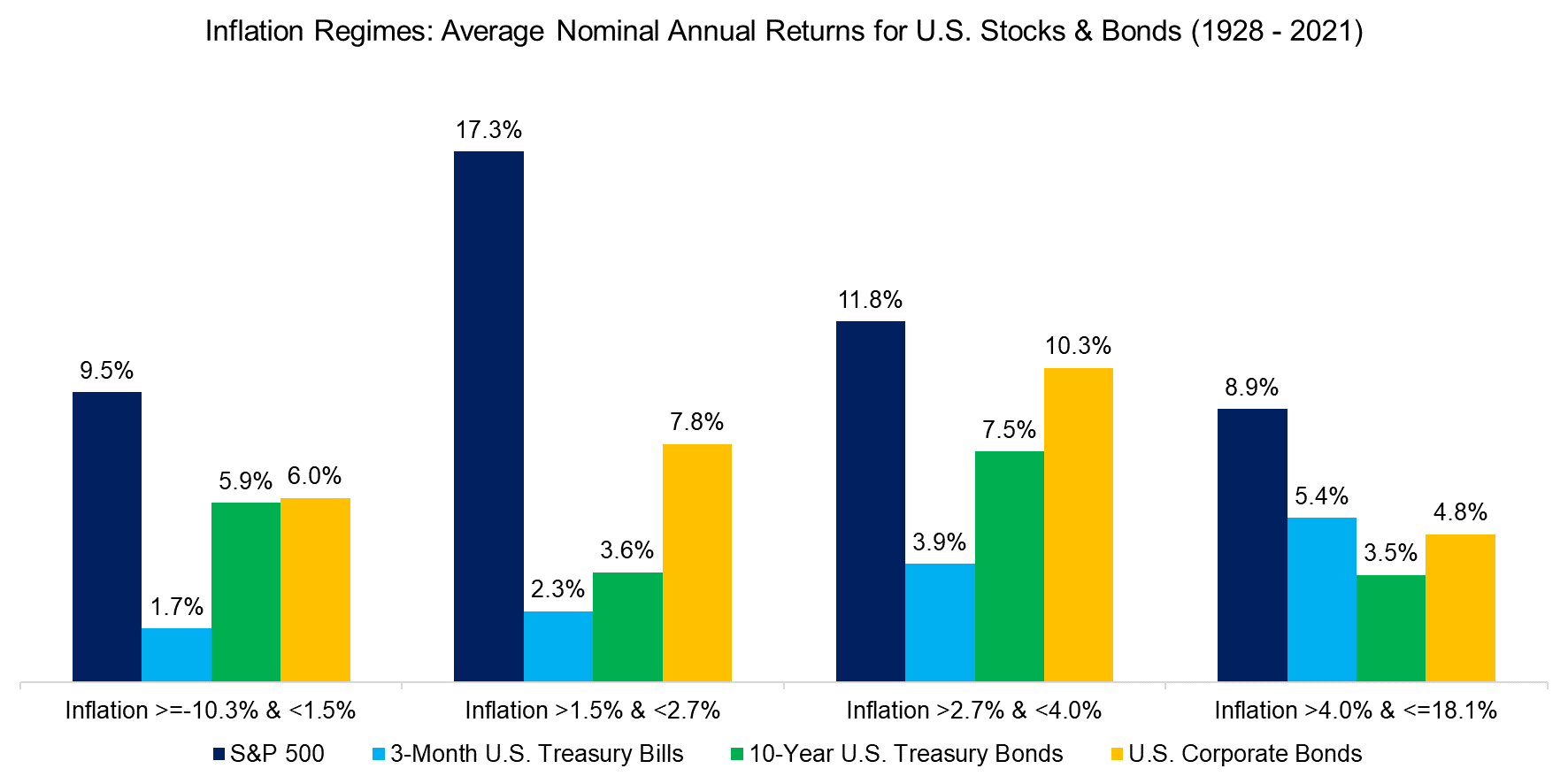
Source: FactorResearch
However, the graphic above shows nominal returns, i.e. before inflation. If a bond yields 5%, but inflation is 10%, then the real return would be -5%. Although foreign to the mindset of most investors, the real return of a portfolio is the only relevant performance metric as that shows how the purchasing power of the invested capital evolves.
Given this, we calculate the real returns, which highlights that stocks and bonds generated the best average returns when inflation was below 1.5%. However, even in the high inflation regime of above 4%, stocks, treasury bills, and corporate bonds produced positive returns.
Perhaps the concerns on inflation creating havoc for traditional 60/40 portfolios are overblown, even on a real return basis.
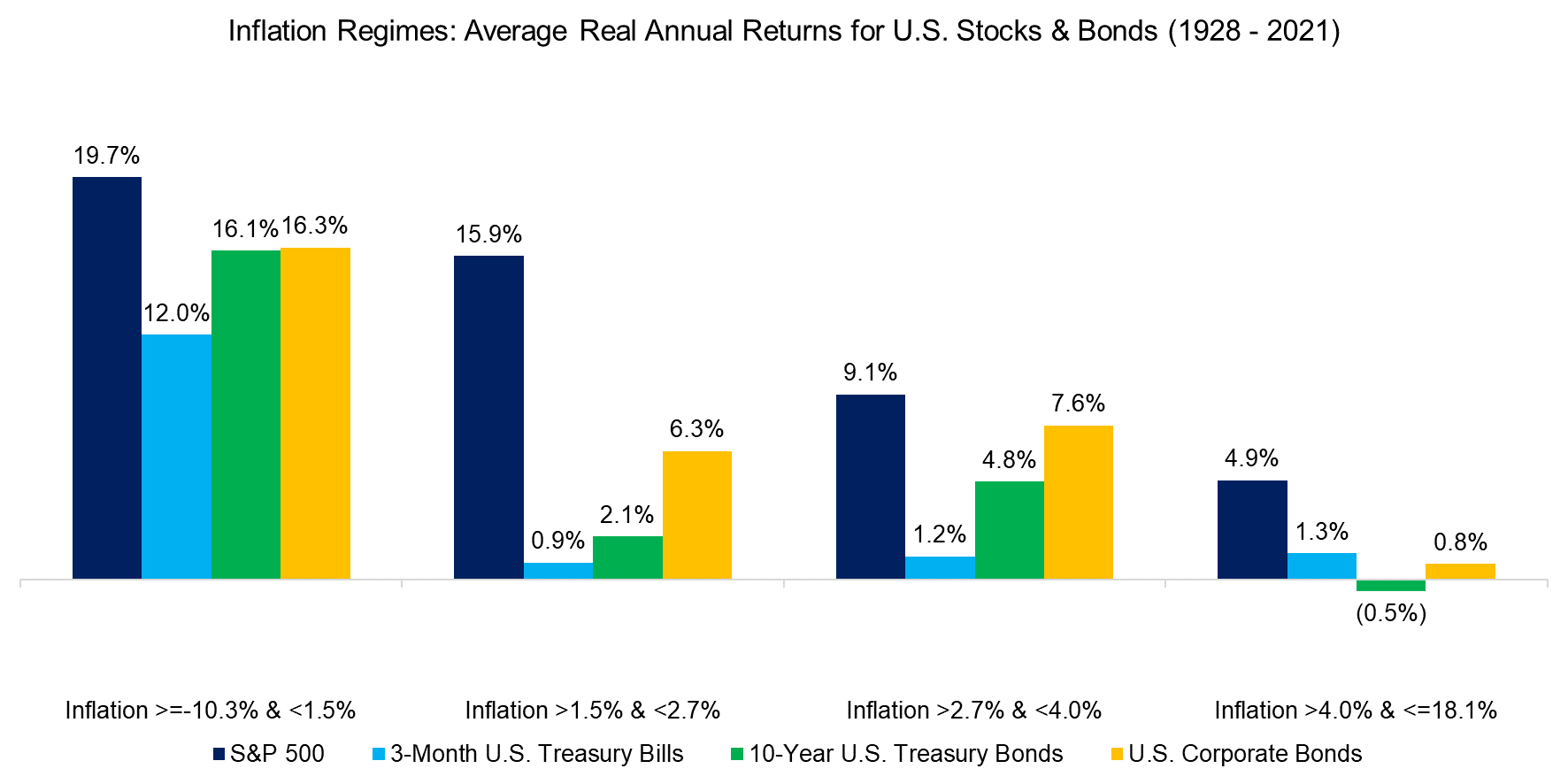
Source: FactorResearch
Although the historical real returns for stocks and bonds have been better than expected, we need to consider that the data set is limited with only 93 years. The few observation points might be influenced by a few significant outliers, so, therefore, we recalculate the real returns using the median rather than the average.
Unfortunately for investors, this shows that inflation above 4% does have severely negative consequences for the real returns of fixed-income securities. Treasury bills, treasury bonds, and corporate bonds all generated negative returns for their investors (read Inflation-Linked Bonds for Inflationary Periods?).
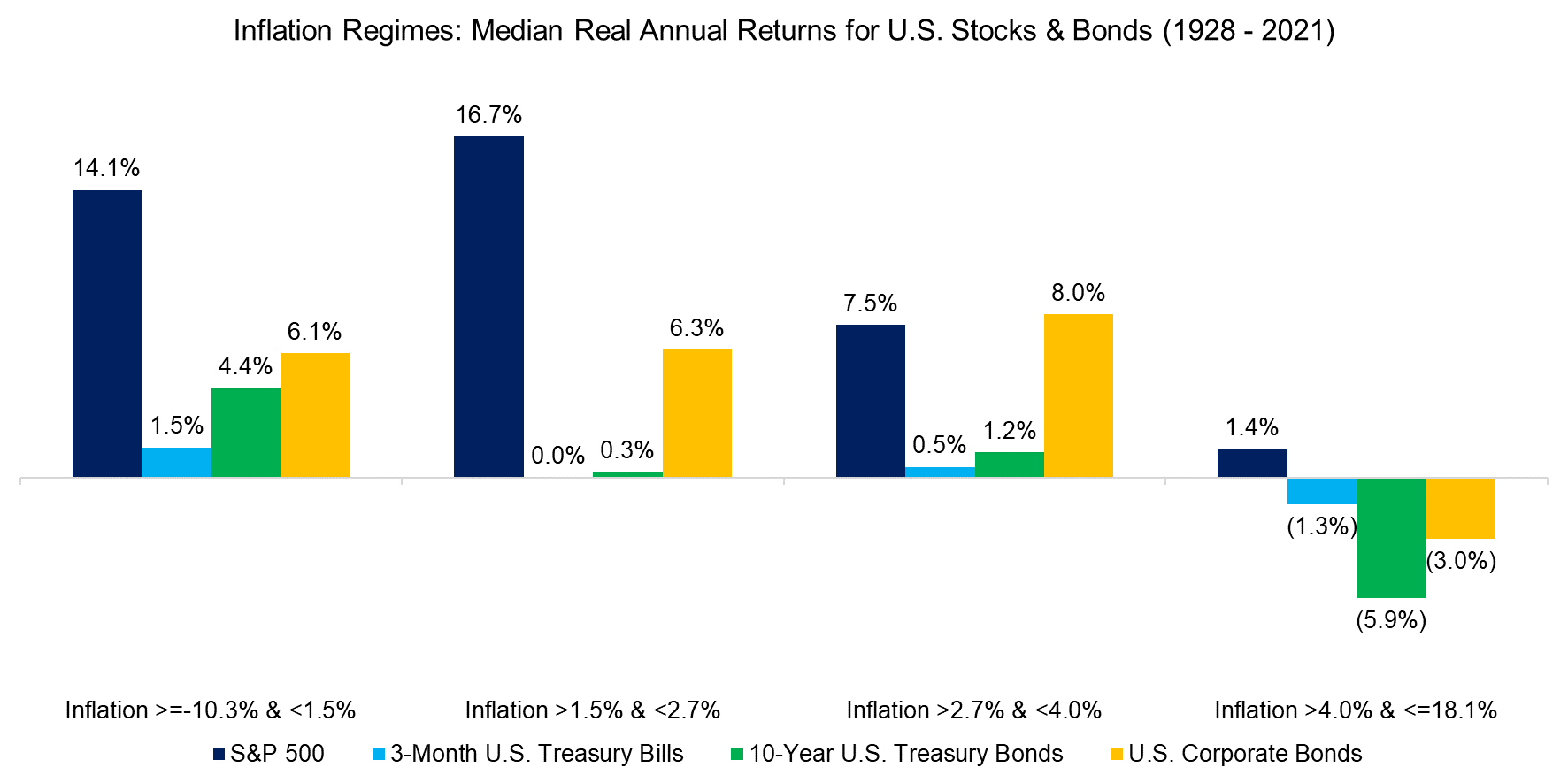
Source: FactorResearch
VISUALIZING THE LONG-TERM PERFORMANCE OF STOCKS AND BONDS
Most academic research in finance shows analysis in tables, but this is often misleading. Although it is helpful to know that inflation was 3.1% on average in the U.S., this includes inflation ranging from -10% in 1932 to 13% in 1979, which had significantly different consequences for the economy. Showing financial analysis in charts typically provides a clearer perspective.
Plotting the performance of stocks and bonds using real returns highlights that stocks generated the highest return since 1928, as expected. This applies to most stock markets globally, except for those countries wrecked by wars or regimes (excellent data on how much money can be lost with stocks is found in Credit Suisse’s Global Investment Returns Yearbook series).
However, it also shows that bonds generated a negative return in the 40 years from 1940 to 1980, which includes various market and economic cycles, including World Word II. Holdings bonds in that period would have consistently reduced the purchasing power of such a portfolio, leaving investors poorer.
We also observe that once the U.S. Fed started winning the fight against inflation in the 1970s, this resulted in the decade-long bond bull market that has shaped the perception of most investors alive today.
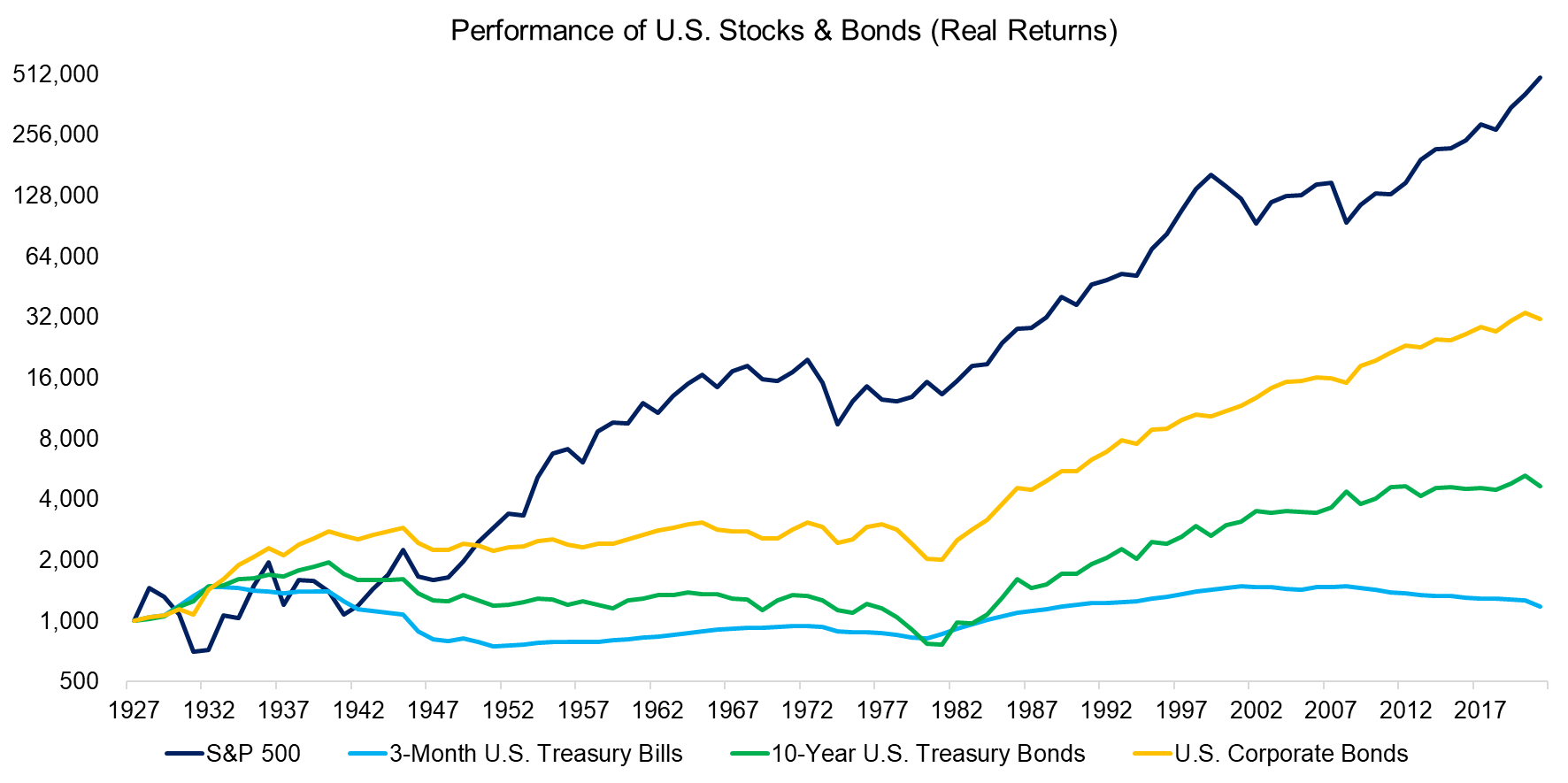
Source: FactorResearch
MAXIMUM DRAWDOWNS OF STOCKS & BONDS
We can further illustrate the riskiness of bonds by highlighting the maximum drawdowns since 1928. Using real returns, this shows that Treasury Bills and Bonds were as risky as equities as drawdowns of approximately 50% were reached. The drawdowns would have been larger if we were using daily instead of annual returns
Worse, in some periods like the 1970s, the drawdowns occurred simultaneously for stocks and bonds, i.e. these were positively correlated and there were limited diversification benefits.
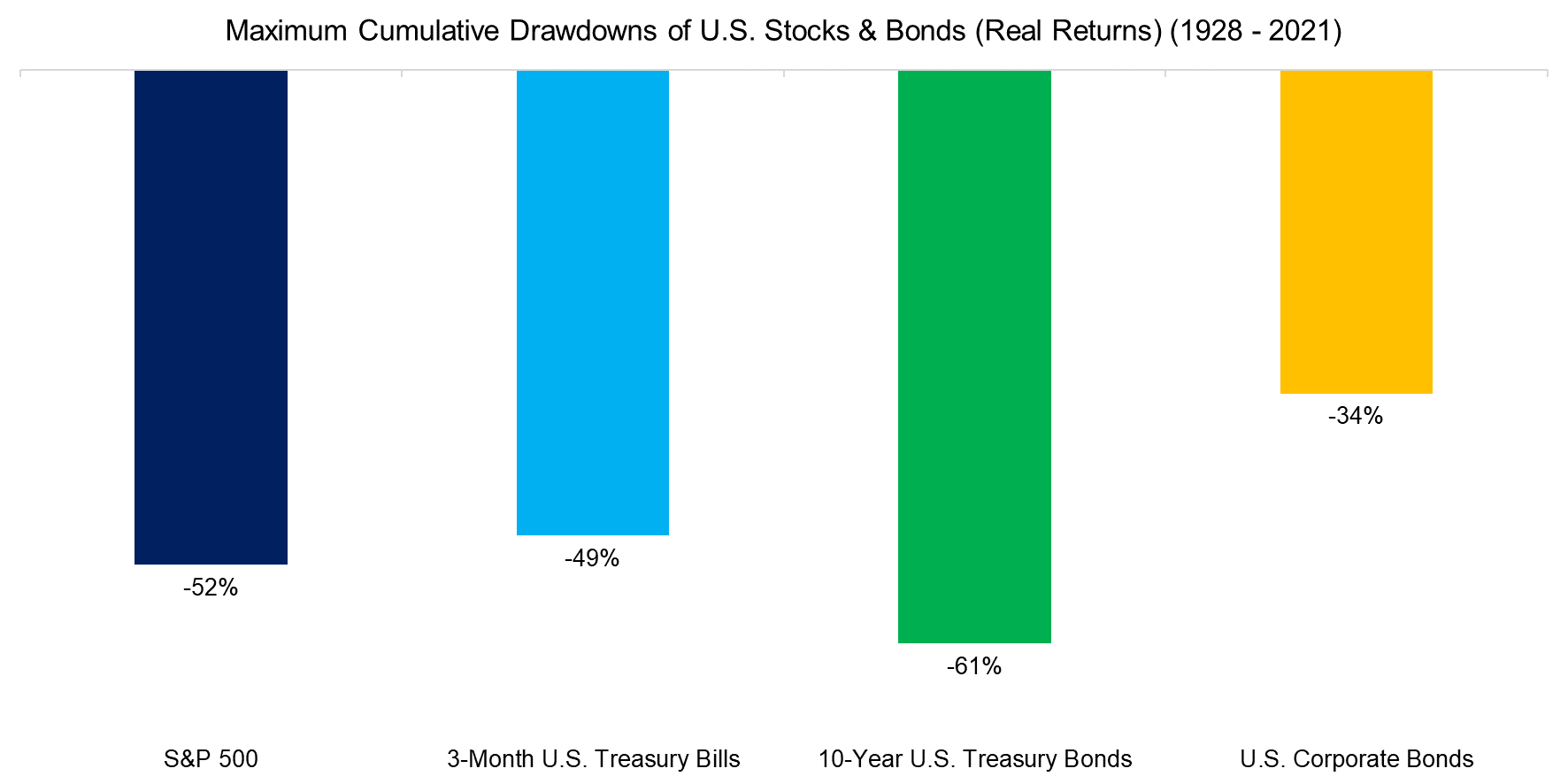
Source: FactorResearch
FURTHER THOUGHTS
Investors need to rapidly change their perception of bonds and adapt their portfolios as they are unsuitable for the short and long term.
In the short-term, there is a risk that inflation remains high for a few years as central banks are unwilling to raise interest rates further as that will negatively impact public finances and mortgage markets, which will create a recession. Traditional 60-40% portfolios would suffer in such a scenario given low or negative real returns.
In the long-term, the governments of some countries will struggle to refinance their public debt given their declining populations. Japan is likely the first country from developed markets that will face this issue, which will require a debt restructuring. Central bank shenanigans may prolong this, but ultimately the piper needs to get paid.
RELATED RESEARCH
60/40 Portfolios Without Bonds
Bonds & The Invisible Thief
Building a Diversified Portfolio for the Long-Term – Part II
ABOUT THE AUTHOR
Nicolas Rabener is the CEO & Founder of Finominal, which empowers professional investors with data, technology, and research insights to improve their investment outcomes. Previously he created Jackdaw Capital, an award-winning quantitative hedge fund. Before that Nicolas worked at GIC and Citigroup in London and New York. Nicolas holds a Master of Finance from HHL Leipzig Graduate School of Management, is a CAIA charter holder, and enjoys endurance sports (Ironman & 100km Ultramarathon).
Connect with me on LinkedIn or X.

